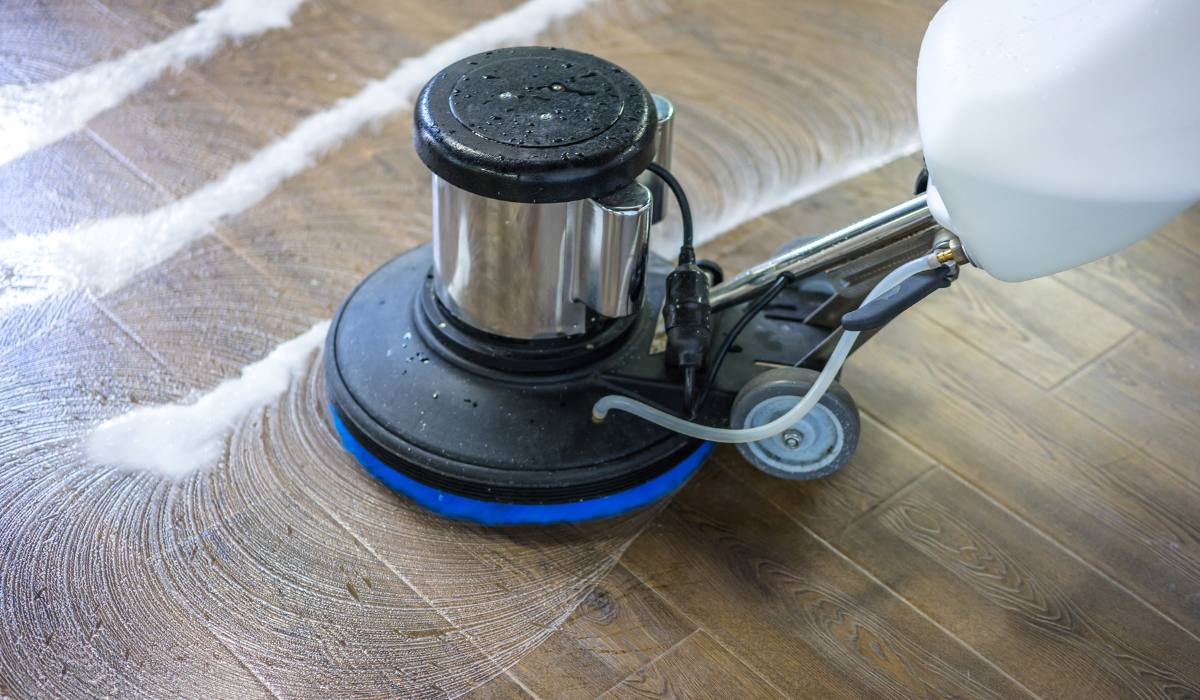Wooden floors are the top choice of most contemporary homeowners. The timeless elegance and classic sophistication of the material contributes to its popularity. But it is also necessary to consider that wooden floors require careful maintenance to ensure longevity. Cleaning wooden floors need not be a tedious task, but there are some things you should steer clear of while undertaking it. Read on to find out about some common mistakes you should avoid while cleaning wooden floors.
See also: How to clean wooden floors?
Using excess water
Wood is highly sensitive to moisture and has the tendency to expand and contract with changes in humidity. Using more water than required while cleaning wooden floors can cause moisture to seep into the seams, cracks or unsealed areas, thereby causing problems like swelling, warping, or even mould growth beneath the surface. While mopping the surface, make sure to wring out the cloth being used until it is barely damp. Consider switching to a microfiber mop, which can clean effectively using minimal water, and pair with a wood-specific cleaning solution diluted as per instructions for deeper cleaning.
Using harsh cleaning products
Substances like vinegar, ammonia and bleach that are too acidic or alkaline can degrade the protective finish on your floors. This results in dull-looking floors that are exposed to potential damage. pH-balanced cleaners specifically formulated for hardwoods can clean the surface without stripping the finish. Unless specifically proven to be safe for woods, steer clear of any all-purpose cleaning solutions.
Skipping sweeping or vacuuming
If not cleaned regularly, dust, dirt and small debris tend to accumulate and act like sandpaper when walked on, causing tiny scratches that can dull the finish over time. The accumulation of such wear further leads to noticeable damage. Get rid of such particles by sweeping the floors daily with a soft-bristle broom or a dust mop. If you are using a vacuum cleaner, clean thoroughly using a separate hardwood floor attachment to avoid any damage to bare floors during the cleaning process.
Using the wrong vacuum attachment
The beater bar or rough brush of a vacuum cleaner can leave scratches or dents on the floor. This problem is further aggravated if the finish is thin or the wood is softer. It is recommended to remove the beater bar of the vacuum cleaner before using it on wooden floors or use it with a hardwood setting. There are soft-bristle attachments available for vacuum cleaners that are designed to protect delicate surfaces while also removing dust effectively.
Not protecting floors from furniture
The legs of furniture like chairs, tables and sofas often tend to scratch, dent or gouge wooden floors, especially if they’re moved from one place to another frequently by being dragged along. If you move your furniture often, it is best to do it by lifting it up instead of dragging. Alternatively, you can attach felt pads or furniture coasters to the bottom of the legs and replace them periodically as they wear down. For particularly heavy furniture, consider placing rubber pads or area rugs underneath.
Ignoring spills
Liquid spills, especially the highly pigmented ones like wine or coffee, can seep into seams or unsealed areas of the floor and cause discoloration or stains. Moreover, prolonged exposure of the wood to liquid can lead to swelling or rotting. Avoid this by acting promptly and immediately blotting any spills with an absorbent cloth or paper towel. Make sure not to rub as it can spread the liquid and cause further damage. If the spill is stick, use a slightly dampened cloth for the job and follow it up with a clean, soft towel to dry up the area.
Skipping mats and rugs
Areas like entryways are high-traffic areas that are more prone to dirt, grit and moisture are often tracked in from outdoors. These places can benefit from the use of mats as elements can scratch or damage the finish and cause wear over time. Consider placing high-quality, non-slip mats or rugs at all entry points, preferably ones with breathable backings like natural fibre, to prevent trapping moisture underneath. Do not forget to clean these rugs regularly to prevent buildup of abrasive dirt.
Over-polishing or waxing
While polishing can enhance the appearance of your wooden floors, excessive use of the material on the surface leads to buildup, creating a cloudy, slippery surface. Same goes for waxing, as it can interfere with the application of future sealants. The polish should be refreshed sparingly with careful adherence to the manufacturer’s instructions, preferably just once every few months. In the case of wax, the first step is to ensure that your floor type indeed requires it, as many modern floors come pre-finished and don’t need waxing.
Using abrasive tools
Needless to say, hard scrubbers like steel wool or stiff-bristled brushes can scratch the floor’s protective finish, thereby exposing the wood beneath and making it vulnerable to moisture and stains. If you need to address tough stains or scuffs, it is recommended to use a soft microfibre cloth or sponge paired with a wood-safe cleaner and apply gentle pressure. For particularly stubborn spots, simply test the cleaner in an inconspicuous area first.
Skipping regular maintenance
While dirt and minor scratches might not seem much initially, they tend to accumulate over time and degrade the floor’s appearance. Neglecting maintenance can also shorten the lifespan of the floor’s finish, calling for more frequent refinishing. Regular cleaning, including daily sweeping and weekly mopping, is key. Further, it is advisable to recoat the floor with a fresh layer of PU every few years to protect it from wear and deep clean annually to remove ingrained dirt.
FAQs
Can I use a steam mop on wooden floors?
Steam mops are not recommended for wooden floors as heat and moisture can damage the finish, warp the wood and cause structural issues.
Is vinegar safe for cleaning wooden floors?
Despite being a natural cleaner, the acidity of vinegar can strip the finish, dull the surface and weaken the protective seal of wooden floors.
How often should I polish my wooden floors?
Depending on the foot-traffic of the area, polishing can be done once in every 2 - 3 months or less, as over-polishing can lead to buildup and dullness.
What is the best way to remove tough stains or scuff marks?
Gently rub the stain with a soft cloth and a wood-safe cleaner and avoid any abrasive scrubbers or harsh chemicals.
How can I protect my floors from furniture scratches?
Use felt pads, furniture coasters or rubber caps under furniture legs and replace them periodically as they wear out, and consider lifting instead of dragging.
Can I use an all-purpose cleaner on wooden floors?
All-purpose cleaners may contain harsh chemicals not suited for use on wood as they may damage the finish or leave a sticky residue.
What is the most common wooden floor maintenance mistake?
Using excessive water for cleaning is the most common mistake as it can seep into cracks and seams, leading to warping, swelling and rot.
| Got any questions or point of view on our article? We would love to hear from you. Write to our Editor-in-Chief Jhumur Ghosh at jhumur.ghosh1@housing.com |







